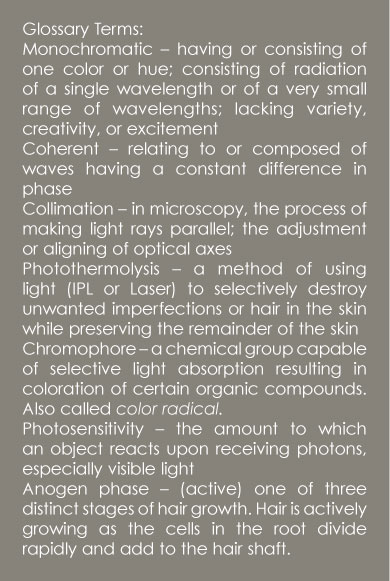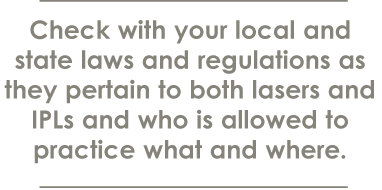I love that last one, especially since I’m 40 and balding… makes me feel all warm and fuzzy inside.
There are so many facets of laser and IPL hair removal to understand, that it will be difficult to fit them all into one article, in one month’s magazine. The intent of this is to give you a start on things to think about; a brief look into what is the truth behind all of the hubbub. Like I say to my nervous clients, “Relax, the anticipation is far worse than the actual treatment…” Are you ready?
First question – "How does it work?" Regardless of laser or IPL, we are using light energy to destroy a hair bulb by a process called photothermolysis. Let's break that down from its latin form. Photo meaning light, therm meaning heat and lysis meaning to destroy. Simply put, we are using light and heat to destroy the follicle. The goal is to use the right amount of light energy to heat and destroy a hair follicle. The light energy is absorbed and transformed into heat energy by an object referred to as a chromophore. A chromophore is a light absorbing target.
In the case of hair reduction, our chromophore is the pigment in the hair follicle. Did you ever walk barefoot onto your driveway or the beach on a sunny day and just about burn the heck out of your feet? That's because the pigment in the asphalt or the sand had absorbed all of that light energy. Energy is a constant – it changes forms, but never really goes away. So all of that light energy from the sun had been absorbed and changed into heat energy. Using light energy from laser or IPL works in a similar manner; the pigment in our hair absorbs that light energy, heats up quickly, and burns to the point of destruction of the hair bulb. The tricky part is to only destroy the hair bulb and not damage the surrounding tissues.

On to question number two… yes, there is a difference between laser and IPL. Lets chat a bit about lasers first.
LASER is an acronym – Light Amplification by the Stimulation of Emitted Radiation. You probably won't remember that or have need to repeat it, but what I want you to understand is that a laser is a single wavelength of light (monochromatic) that moves together at the same time in the same space (coherent), and can be focused to travel in a single direction with little or no divergence (collimated). Divergence is simply spreading or moving apart, ordinary light from a light bulb is highly divergent – it spreads out in all directions very quickly.
What makes laser light so special is the control we have over it. Since light travels in waves, and we know the effects or properties that different wavelengths have on different targets, we have a great tool when used properly to have a safe and effective treatment for our clients. One of the properties of different wavelengths is the depth to which it penetrates into the skin. Shorter wavelengths don't penetrate as deeply; they tend to scatter more quickly closer to the surface. An example of this would be a blue sky or a red sunset. The sun puts out all sorts of different wavelengths of natural light, from short ultraviolet rays to the much longer infrared. Blue is a shorter wavelength in our visible spectrum, the light that we can see, around 500nm or so. Because of this, its energy tends to scatter in the upper atmosphere and thus the sky appears blue. Red is a longer wavelength, around 720nm or so, and thus has ability to penetrate further. So those spectacular sunsets of deep reds that we see are caused by all of those other shorter wavelengths (purples, blues, greens, yellows) being scattered away in our atmosphere and leaving those longer reds and crimsons to be visible (penetrating deeper into our atmosphere), thus giving us the appearance of a nice red sunset!
There are a host of other variables associated to consider before we pulse a laser or IPL on a client. Are they on any medications which can cause photosensitivity? Is there enough pigment in their hair for a worthwhile treatment? Blonde or fine vellus hair is very minimally affected by both laser and IPL treatments and are quite likely not worth the time or money to the client. What is their skin type or Fitzpatrick rating? Even that is becoming ambiguous as our culture is such a melting pot of races and ethnic backgrounds. That alabaster beauty with blue eyes and dark hair (a great candidate for laser or IPL hair reduction) may have a grandfather from Asia or South Africa. So how may her skin react to an intense pulse of light?! Who knows, she may be perfectly fine, or she may blister instantly – trust me, it's happened to plenty of doctors, LPNs, Laser Technicians, aestheticians, and anybody else brave enough to perform these procedures.
Having said all of that, your longer wavelength lasers can be used on any skin type. By virtue of the wavelength combined with spot size, we have the ability to drive the energy past the pigment in the epidermis – where it would heat and burn the skin, and target the pigment in the hair follicle with minimal damage to surrounding tissues.
Now for IPLs. IPL stands for Intense Pulsed Light. The concept is simple, we are using a lamp (like a flash on a camera), delivering an unbelievably intense pulse of light energy to affect a change in a target… still photothermolysis, still targeting chromophores – just using a whole spectrum of light wavelengths to do it.
IPLs typically have a larger spot size – the size of the area being affected by the individual pulse, and the light that they produce is highly divergent. Remember divergence? The light from an IPL treatment is a whole host of wavelengths (typically approximately 400nm through approximately 1200nm) and contains both visible and invisible light. On that note… if you or someone you know has had "laser hair removal" and they saw a bright flash of light, they most likely had an IPL treatment, not laser. Here's the other catch; you've probably heard somewhere along the way that African American or darker skinned clients (Fitzpatrick 4, 5, 6) can't get laser hair removal. WRONG. They can't get IPL hair removal treatments, but many lasers can be used safely and effectively in hair reduction for our clients of darker skin colors. The reason the IPL isn't safe or effective for darker skin is because of all of the different wavelengths of light. Remember we said that typically the longer the wavelength the deeper the penetration. Since IPLs have a variety of wavelengths, the shorter wavelengths may not penetrate to where they are needed, the bulb of the hair; they get snagged in the upper layers of the skin in red and brown pigments. The energy from those short wavelengths can get picked up by the pigment in the skin of darker individuals. That pigment in the skin will do the same as the hair follicle. It will grab that energy, heat up, and cause damage. Except instead of damage at the bulb where we want it, we'll cause damage in the skin, where we don't want it. The result can be as minimal as a slight burn or blister, which will heal in a short time, to an extreme of hyper- or hypopigmentation, or even a scar for a lifetime.

Regardless of the procedure used, when used correctly the results can be satisfying to both the client and practitioner. Set realistic expectations for your client. Since we typically only destroy or damage the hair bulb in the anogen phase, multiple treatments are necessary. Remember, it's not permanent hair removal, it is permanent hair reduction. The bulbs that we destroy will not produce hair. However, new hairs may grow, fine or vellus hair probably won't be affected and hormonal changes may cause growth of new hair that will need attention according to the client's desire. Shaving and tweezing will be greatly reduced and the dark, thick hair that the client has may be gone for good. However, some fuzz or a "lone wolf" hair might still be around long after several treatments. Follow up or touch up treatments may be necessary some time down the road.

By now you may be saying to yourself "I had no idea there was so much theory and science behind something as simple as hair removal." Waxing or electrolysis seem to be easier to understand… none of this science and physics stuff. Well, if you understand the different effects that different lasers have according to their wavelengths, then you're on the road to understanding what lasers work best for your application and your client! So, when choosing a laser or IPL system, make sure your wavelength is compatible with the targets you'll be primarily selecting. It seems that a 1064YAG has become a popular choice for hair removal. Understand as well that IPL's work great as well, typically cost less than lasers, but have some limitations as to who and what you can most effectively practice on.
Also, please be sure to check with your local and state laws and regulations as they pertain to both lasers and IPLs and who is allowed to practice what and where. In some states, anybody can perform services on any level with no training or certification necessary. In other states, there are strict guidelines as to who can perform what type of procedures and what training is mandatory prior to performing services. Some states are limited to doctors only. So please check, and then check again. The bottom line is that it is one alternative to permanent hair reduction that can leave clients happy and offers a profitable service to be added to your menu.
As I said at the beginning of this article, education is the key. The more knowledge you have and the better prepared you are at understanding the intricacies involved in a laser or IPL treatment, the better off your clients and the industry as a whole will be. Until next time, happy hair removal.
Randy Brenner is a certified laser technician and educator. He has both a biology and chemistry background, as well as over 15 years experience as a business owner. Brenner owns and operates Dimensions in Aesthetic Advancement, the Northeast distributorship for Circadia skin care products and advanced aesthetic equipment. He is also a contributing author for industry trade magazines and expert guest speaker.
